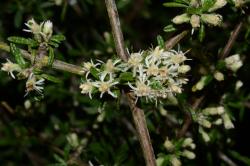- Taxon
- Gallery
- ≡ Olearia virgata var. rugosa G.Simpson, Trans. Roy. Soc. New Zealand 75: 199 (1945)
- = Olearia virgata var. β Hook.f., Handb. New Zealand Fl. 128 (1864)
Shrub up to c. 2 m tall. Bark light fawn, becoming moderately rough and furrowed on old branches and trunk. Branchlets diverging at a wide angle, slender, fawn-brown to orange-brown or dark brown, quadrangular, glabrous; internodes of long shoots (2-)3(-3.5) cm long. Short shoots opposite and decussate, each bearing up to about 12 leaves and/ or 1-3 capitula when young; older short shoots leafless, rough with closely ranked leaf scars. Leaves opposite or in opposite fascicles, linear-oblanceolate to narrowly oblanceolate, c. 8-12 × 1-2 mm; upper surface of lamina mid-green, somewhat shiny, with abundant fine appressed hairs when young, glabrescent with age, markedly bullate; margins strongly revolute almost to midrib at least when young, opening a little when mature to reveal lower surface clad in dense silvery white tomentum; midrib deeply sunken above, prominently raised throughout length beneath, greenish or brownish, hairy; apex obtuse, with a small brown to red-brown apiculus often nestled in a tuft of white hairs; base of lamina tapering gradually to petiole; petiole densely hairy with fine, white, mostly appressed hairs above and beneath. Capitula c. 6-9 mm long, scented. Peduncle c. 1-4 mm long, soft, flexible, hairy, with thin brown bracts at base c. 1-1.5 mm long, shorter peduncles ebracteate above; longer peduncles with 1(-2) pairs of leaf-like, opposite or single, oblanceolate bracts up to 5 or 6 mm long. Involucre cylindric to narrowly ovoid; involucral bracts spiralled, in three series, light green, hairy, with very hairy white margins and densely hairy apex bearing white crisped hairs. Florets c. 9-10 per capitulum, outer 5-7 florets pistillate, ligulate with deflexed white limb c. 2.5 mm long and white to cream stigma; inner few florets hermaphrodite, eligulate, with orange-yellow anthers and dark reddish purple papillose stigma. Achenes papillose-pubescent to nearly glabrous; pappus hairs greyish white, about 3.5 mm long.
[Reproduced from Wilson & Garnock-Jones (1992, New Zealand J. Bot. 30: 365–368) with permission from The Royal Society of New Zealand.]




